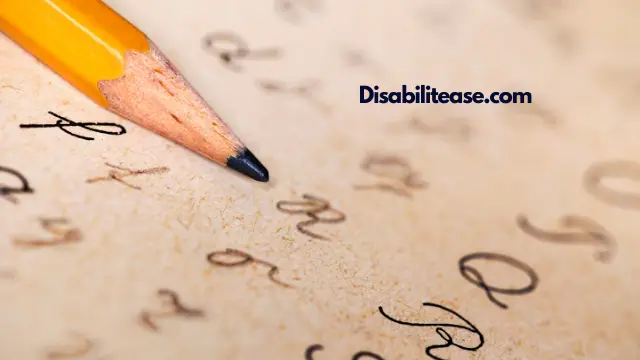Can Dyslexia affect handwriting? Dyslexia causes difficulty in reading, spelling, and comprehension of written material. Most cases of Dyslexia are genetic but can be caused due to traumatic brain injuries as well.
Affected individuals often struggle to maintain a normal academic life due to their low visual processing abilities and phonological awareness.

Being a neurological condition, it manifests differently in each individual with varying symptoms. Two primary subtypes of Dyslexia include Visual Dyslexia and Auditory Dyslexia.
Auditory Dyslexia impacts one’s phonological awareness more heavily and makes it difficult to spell out the different sounds of letters, words, and digits.
We have a related article for you, you can read Can Dyslexia Develop With Age?
In comparison, Visual Dyslexia impairs the ability to understand the visual structure of writing material effortlessly. This makes words and numbers harder to recognize and extract meaning from.
Table of Contents
Can Dyslexia Affect Handwriting?
A 2016 study on children with Dyslexia found that the condition causes persistent difficulty in writing fluently and accurately. Most difficulties recorded include incorrect letter formation, slower writing speed, and writing composition.
Such difficulties are also present in average learners who are not diagnosed with any disorders or disabilities. However, dyslexia-related difficulties can be distinguished based on frequent spelling mistakes related to phonological awareness and working memory.
Another study from 1980 compared the writing and drawing skills of children with Dyslexia and normal learners. It is commonly believed that Dyslexia is only a visual processing and reading disorder. This often leads to handwriting problems being dismissed as an unrelated challenge usually caused by low graphomotor skills.
However, Dyslexia causes very specific handwriting problems that can be directly linked back to it. The study found that children with Dyslexia performed equally well in the drawing tasks and only struggled with writing tasks.
This study helps rule out the possibility of low graphomotor skills as the main cause of poor handwriting in Dyslexic Individuals.
Some of the common handwriting problems caused by Dyslexia are explained below.
Inaccuracy
Inaccuracy in handwriting is the primary factor affected by Dyslexia. Learners often struggle to write down their ideas and homework with the right letter direction, spelling, and formation.
Letter reversal is a common occurrence where students often mistake one letter for another. This usually happens with mirrored letters such as ‘b’, ‘d’, ‘q’, and ‘p’. For example, affected individuals may write the word “bad” as “dab” or “dad” without realizing the mistake.
Along with letters, word reversals such as writing “saw” as “was” and “mad” as “dam” is also common. This leads to the writing material carrying more errors than the average person. Young learners who do not receive intensive support and appropriate writing instructions struggle with capitalization as well.
They may use uppercases and lowercases interchangeably within both the starting of a sentence and within words.
Misspelling
Writing effectively involves recreating a specific shape attached to each letter than makes it unique from other letters.
Individuals with Dyslexia have a hard time linking a specific word in their head to its visual composition. This often causes misspelling as the needed letters of one word are often a guess rather than based on memory.
Odd Spacing
Inconsistent spacing can make one’s handwriting look less tidy and unorganized. Due to multiple factors, those with Dyslexia have a hard time understanding the appropriate size of gaps they should leave between each word.
Anxiety, weak working memory, and prioritization of letter recreation are often to blame.
Cramming
This is a common occurrence in almost all of the transcriptions reviewed in studies related to Dyslexia and its implications for handwriting.
Affected individuals tend to cram more information on a single page and paragraph rather than paying attention to organizing and structuring their writing.
Exhaustion
Teachers and parents often observe a smaller quantity of output from dyslexic students compared to other children. The overwhelming strain from multiple symptoms, including low working memory, phonological abilities, and visual recall, can make affected children tired more quickly.
Because writing is highly effortful, only a few paragraphs can drain all their energy for the day. This is also cited as a common cause of poor handwriting in people with Dyslexia. This is because the first few paragraphs may receive more energy and dedication, leading to better handwriting that slowly becomes less tidy as one becomes tired and agitated.
Writing Speed

Individuals with Dyslexia cannot write as fluently and effortlessly as their peers. Multiple studies have found a direct relationship between slow writing speed and Dyslexia.
One comparative study on children with and without Dyslexia found that those with delayed handwriting also showed difficulties in completing reading tasks.
This points toward Dyslexia playing an important role in slowing down one’s writing speed.
Untidy Writing
We all rely on visual memorization of the distinct shapes of each letter to recreate it on paper. However, individuals with Dyslexia have low recognition and memorization abilities regarding letters, words, and digits. This makes it harder to recreate the exact shape of each letter, leading to messy and incomprehensible handwriting.
In most handwritings of affect individuals, the letters are often constructed with less pronounced shapes. The words can also appear bouncy as each letter is usually written in inconsistent sizes. However, inconsistent sizes are not directly related to the condition but as a side effect.
As individuals concentrate on visualizing the shapes in their heads, recalling each letter’s distinct sounds and recreating the shape, size and, visual appeal of their writing often becomes the least concern for them.
Conclusion
Dyslexia is closely related to poor handwriting in young and adult learners. Those with inadequate academic support are likely to suffer more compared to others with the same symptoms.
Also, you have to check out my post on Can Dyslexia Get Worse As You Age?
However, multiple treatments and therapies have become increasingly accessible for learners at all stages of their education. It is suggested that therapies and teaching practices targeted toward improving spelling and visual processing will also lead to improvements in handwriting.
Early intervention and a systematic support system within schools are essential to help affected individuals overcome poor handwriting and speed. One common remedial approach includes assessing the transcription of each learner and providing continual, specific suggestions.
For example, telling a student to “add a gap equal to your finger after each word” can be more helpful than simply telling them to “improve” their writing.

Hi, my name is Eddie, I am a professional trainer specializing in the elderly population and I’m also a website designer. I love training in the gym, going to the beach, traveling, and having good food.
I combined my love for sport and website designing to make “DisabilitEase” whose purpose is to help elderly and disabled people live a more full and active life, have more fun, and enjoy their unique journey despite any disability.



